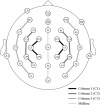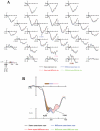On the time course of letter perception: a masked priming ERP investigation
- PMID: 17201369
- PMCID: PMC1857301
- DOI: 10.3758/bf03193980
On the time course of letter perception: a masked priming ERP investigation
Abstract
In an experiment measuring event-related brain potentials (ERPs), single-letter targets were preceded by briefly presented masked letter primes. Name and case consistency were manipulated across primes and targets so that the prime was either the same letter as the target (or not), and was presented in the same case as the target (or not). Separate analyses were performed for letters whose upper- and lowercase forms had similar features (or not). The results revealed an effect of prime-target visual similarity between 120 and 180 msec, an effect of case-specific letter identity between 180 and 220 msec, and an effect of case-independent letter identity between 220 and 300 msec. We argue that these ERP results reflect processing in a hierarchical system for letter recognition that involves both case-specific and case-independent representations of alphabetic stimuli.
Figures




Similar articles
-
An ERP investigation of location invariance in masked repetition priming.Cogn Affect Behav Neurosci. 2008 Jun;8(2):222-8. doi: 10.3758/cabn.8.2.222. Cogn Affect Behav Neurosci. 2008. PMID: 18589511 Free PMC article.
-
On the time course of the tolerance of letter detectors to rotations: A masked priming ERP investigation.Neuropsychologia. 2022 Jul 29;172:108259. doi: 10.1016/j.neuropsychologia.2022.108259. Epub 2022 May 13. Neuropsychologia. 2022. PMID: 35569562
-
Neural correlates of visual versus abstract letter processing in Roman and Arabic scripts.J Cogn Neurosci. 2013 Nov;25(11):1975-85. doi: 10.1162/jocn_a_00438. Epub 2013 Jun 28. J Cogn Neurosci. 2013. PMID: 23806176 Free PMC article.
-
Masked orthographic priming in bilingual word recognition.Mem Cognit. 1997 Jul;25(4):447-57. doi: 10.3758/bf03201121. Mem Cognit. 1997. PMID: 9259623
-
From numbers to letters: feedback regularization in visual word recognition.Neuropsychologia. 2010 Apr;48(5):1343-55. doi: 10.1016/j.neuropsychologia.2009.12.037. Epub 2009 Dec 28. Neuropsychologia. 2010. PMID: 20038435
Cited by
-
Letters, Words, Sentences, and Reading.J Cogn. 2024 Aug 27;7(1):66. doi: 10.5334/joc.396. eCollection 2024. J Cogn. 2024. PMID: 39220856 Free PMC article. Review.
-
Multiple routes to word recognition: evidence from event-related potentials.Psychol Res. 2021 Feb;85(1):151-180. doi: 10.1007/s00426-019-01256-5. Epub 2019 Oct 17. Psychol Res. 2021. PMID: 31624919
-
Consonantal overlap effects in a perceptual matching task.Exp Brain Res. 2016 Nov;234(11):3157-3172. doi: 10.1007/s00221-016-4713-6. Epub 2016 Jul 2. Exp Brain Res. 2016. PMID: 27372835
-
Neural mechanism underlying preview effects and masked priming effects in visual word processing.Atten Percept Psychophys. 2025 Jan;87(1):5-24. doi: 10.3758/s13414-024-02904-8. Epub 2024 Jul 2. Atten Percept Psychophys. 2025. PMID: 38956004 Free PMC article.
-
An ERP investigation of visual word recognition in syllabary scripts.Cogn Affect Behav Neurosci. 2013 Jun;13(2):390-404. doi: 10.3758/s13415-013-0149-7. Cogn Affect Behav Neurosci. 2013. PMID: 23378278 Free PMC article.
References
-
- ARGUIN M, BUB D. Priming and response selection processes in letter classification and identification tasks. Journal of Experimental Psychology: Human Perception & Performance. 1995;21:1199–1219.
-
- BOWERS JS, VIGLIOCCO G, HAAN R. Orthographic, phonological, and articulatory contributions to masked letter and word priming. Journal of Experimental Psychology: Human Perception & Performance. 1998;24:1705–1719. - PubMed
-
- CORNELISSEN P, TARKIAINEN A, HELENIUS P, SALMELIN R. Cortical effects of shifting letter position in letter strings of varying length. Journal of Cognitive Neuroscience. 2003;15:731–746. - PubMed
-
- DEHAENE S, COHEN L, SIGMAN M, VINCKIER F. The neural code for written words: A proposal. Trends in Cognitive Sciences. 2005;9:335–341. - PubMed
Publication types
MeSH terms
Grants and funding
LinkOut - more resources
Full Text Sources
